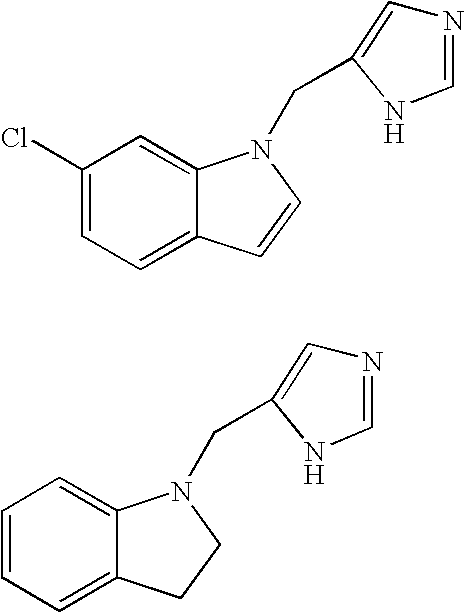Functionally selective alpha2C adrenoreceptor agonists
a technology of adrenergic agonists and alpha2c, which is applied in the field of indoline compounds, can solve the problems that compounds having adrenergic activity, such as 2a agonists, may be associated with undesirable side effects
- Summary
- Abstract
- Description
- Claims
- Application Information
AI Technical Summary
Benefits of technology
Problems solved by technology
Method used
Image
Examples
example 1
Preparative Example 1
To a stirred solution of 6-nitroindoline (8.0 g, 48.8 mmol) in DCM (50 mL) was added pyridine (9.9 mL, 122 mmol), (Boc)2O (10.6 g, 48.6 mmol) and catalytic DMAP. The mixture was stirred overnight. Reaction was washed with brine, and the organic layer was dried (Na2SO4), filtered and concentrated. Chromatography (20% EtOAc / hexanes) provided 1-Boc-6-nitroindoline (10 g, 78%).
To a stirred solution of 1-Boc-6-nitroindoline (3.5 g, 13.2 mmol) in MeOH / EtOAc (80 mL / 40 mL) was added 10% Pd / C (700 mg). The reaction was stirred under H2 (1 atm) overnight. The mixture was filtered through celite and concentrated to give 1A (3.1 g, 100%).
To a stirred solution of compound 1A (1.33 g, 5.68 mmol) in dioxane (36 mL) and H2O (10 mL) at 0° C. was added Na2CO3 (66 g, 6.25 mmol) and Fmoc-Cl (1.61 g, 6.25 mmol). The reaction was stirred at 0° C. for 1.5 h and then at RT for 1 h. Solvent was removed under reduced pressure and the residue was partitioned between H2O (50 mL) and ...
example 2
Preparative Example 2
To a stirred solution of 1H-indole-6-carboxylic acid (1.5 g, 9.31 mmol) in MeOH (200 mL) was added conc. H2SO4 (3 mL). The reaction was refluxed for 15 h and cooled to RT. The mixture was neutralized with sat. NaHCO3 and MeOH was removed under reduced pressure. The remaining mixture was extracted with EtOAc (50 mL×3). The combined organic layer was dried (Na2SO4), filtered and concentrated under reduced pressure. Chromatography (20% EtOAc / hexanes) provided 2A (1.4 g, 88%) as a white solid.
A stirred solution of 2A (1 g, 5.7 mmol) in DCM (20 mL) and TFA (10 mL) at −20° C. was treated with Et3SiH (10 mL). The reaction was warmed to RT slowly and stirred thereafter for 17 h. The reaction was quenched with 2 N NaOH until pH 8. The mixture was extracted with DCM (100 mL×3). The combined organic layer was dried (Na2SO4), filtered and concentrated under reduced pressure. Chromatography (20% EtOAc / hexanes) provided 2B (0.5 g, 49%).
In a manner similar to that found...
example 3
Preparative Example 3
Chlorosulfonic acid (5 g, 42.9 mmol) was cooled in an ice bath and treated with 1-(5-bromoindolin-1-yl)ethanone (2.4 g, 10 mmol). The reaction was stirred at 0° C. for 20 min and then heated to 70° C. for 7 h. After cooling, the mixture was slowly poured onto ice. The precipitate was filtered, washed with H2O and pumped on high vacuum overnight to give a crude mixture containing compound 3A and starting material in ratio of 2:3 as determined by 1H NMR.
One third of the above mixture was dissolved in DCM (10 mL) and treated with MeNH2 (2 M / THF, 5 mL). The reaction was stirred at RT overnight, concentrated, and partitioned between EtOAc and water. The aqueous layer was extracted with EtOAc (2×100 mL). The combined organic layers were dried (Na2SO4), filtered and concentrated. Chromatography (60-100% EtOAc / hexanes) provided 3B (0.39 g).
To Compound 3B (0.39 g, 1.17 mmol) was added 37% HCl (10 mL) and the mixture was refluxed for 1.5 h. The reaction was cooled ...
PUM
| Property | Measurement | Unit |
|---|---|---|
| pharmaceutical composition | aaaaa | aaaaa |
| blood pressure | aaaaa | aaaaa |
| α-adrenergic | aaaaa | aaaaa |
Abstract
Description
Claims
Application Information
 Login to View More
Login to View More - R&D
- Intellectual Property
- Life Sciences
- Materials
- Tech Scout
- Unparalleled Data Quality
- Higher Quality Content
- 60% Fewer Hallucinations
Browse by: Latest US Patents, China's latest patents, Technical Efficacy Thesaurus, Application Domain, Technology Topic, Popular Technical Reports.
© 2025 PatSnap. All rights reserved.Legal|Privacy policy|Modern Slavery Act Transparency Statement|Sitemap|About US| Contact US: help@patsnap.com



